Report on Accounting Principles and Financial Analysis: Unit 5
VerifiedAdded on 2023/06/10
|16
|4749
|214
Report
AI Summary
This report provides a comprehensive overview of accounting principles, encompassing financial, cost, and managerial accounting. It delves into the purpose of accounting within an organization, explaining its role in recording transactions and providing crucial financial information to stakeholders. The report details various types of accounting, including financial, cost, and managerial accounting, and explores the impact of technology on accounting systems. It also addresses regulations, ethics, and compliance within the field, emphasizing the importance of maintaining accurate records and adhering to ethical standards. Furthermore, the report includes a cash budget computation and demonstrates the preparation of financial accounts using accounting principles. Finally, it demonstrates the calculation and interpretation of financial ratios to assess a company's financial performance, providing a complete analysis of accounting practices and their implications.
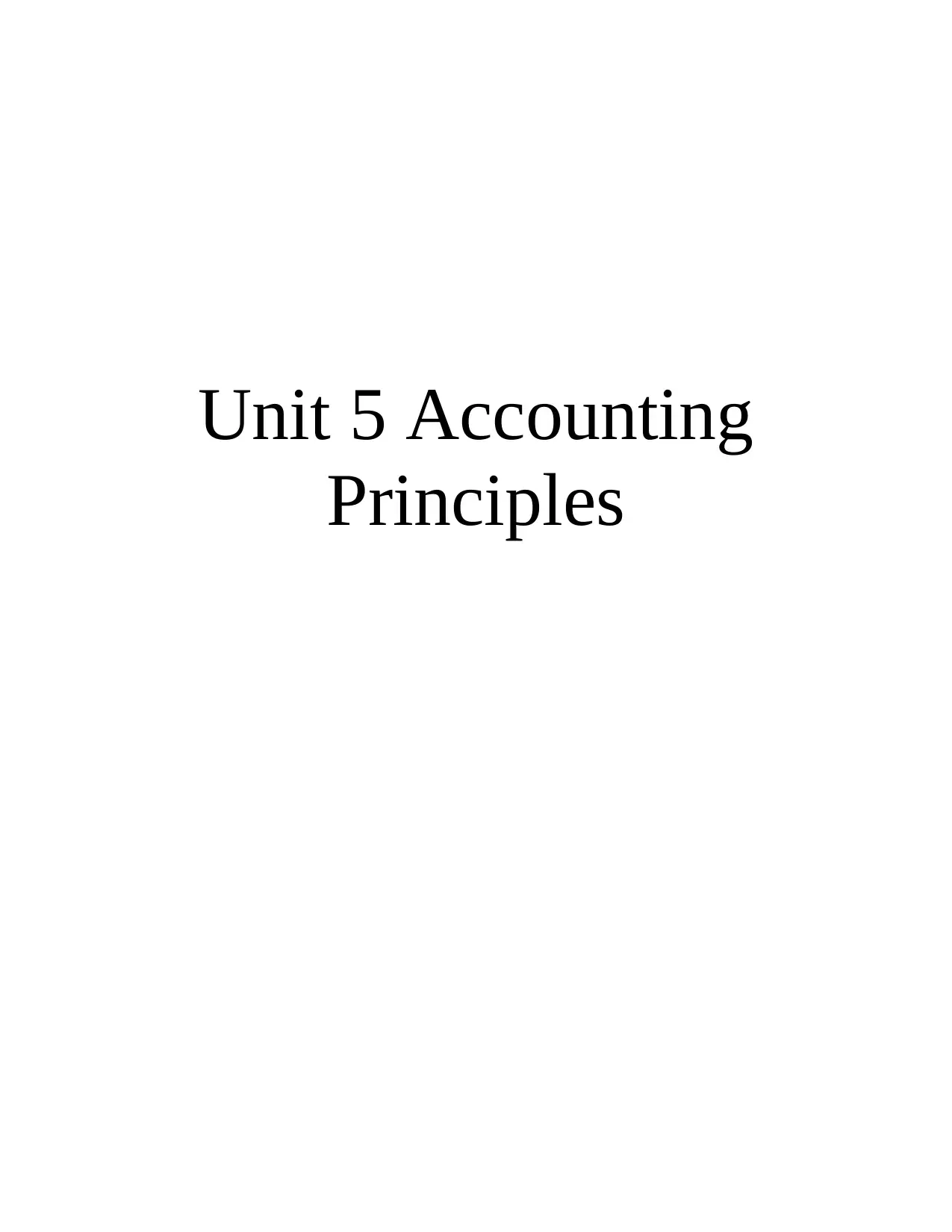
Unit 5 Accounting
Principles
Principles
Paraphrase This Document
Need a fresh take? Get an instant paraphrase of this document with our AI Paraphraser
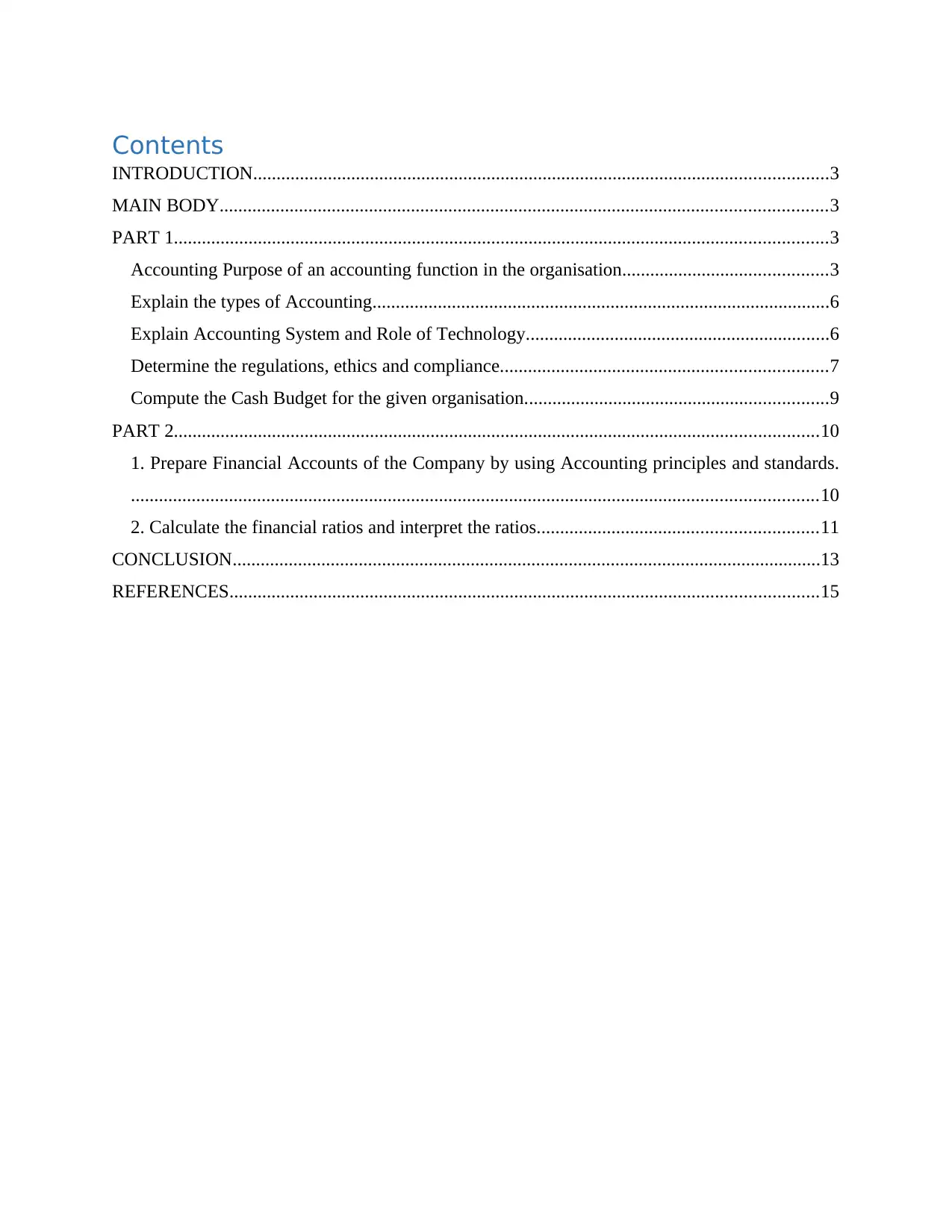
Contents
INTRODUCTION...........................................................................................................................3
MAIN BODY..................................................................................................................................3
PART 1............................................................................................................................................3
Accounting Purpose of an accounting function in the organisation............................................3
Explain the types of Accounting..................................................................................................6
Explain Accounting System and Role of Technology.................................................................6
Determine the regulations, ethics and compliance......................................................................7
Compute the Cash Budget for the given organisation.................................................................9
PART 2..........................................................................................................................................10
1. Prepare Financial Accounts of the Company by using Accounting principles and standards.
...................................................................................................................................................10
2. Calculate the financial ratios and interpret the ratios............................................................11
CONCLUSION..............................................................................................................................13
REFERENCES..............................................................................................................................15
INTRODUCTION...........................................................................................................................3
MAIN BODY..................................................................................................................................3
PART 1............................................................................................................................................3
Accounting Purpose of an accounting function in the organisation............................................3
Explain the types of Accounting..................................................................................................6
Explain Accounting System and Role of Technology.................................................................6
Determine the regulations, ethics and compliance......................................................................7
Compute the Cash Budget for the given organisation.................................................................9
PART 2..........................................................................................................................................10
1. Prepare Financial Accounts of the Company by using Accounting principles and standards.
...................................................................................................................................................10
2. Calculate the financial ratios and interpret the ratios............................................................11
CONCLUSION..............................................................................................................................13
REFERENCES..............................................................................................................................15
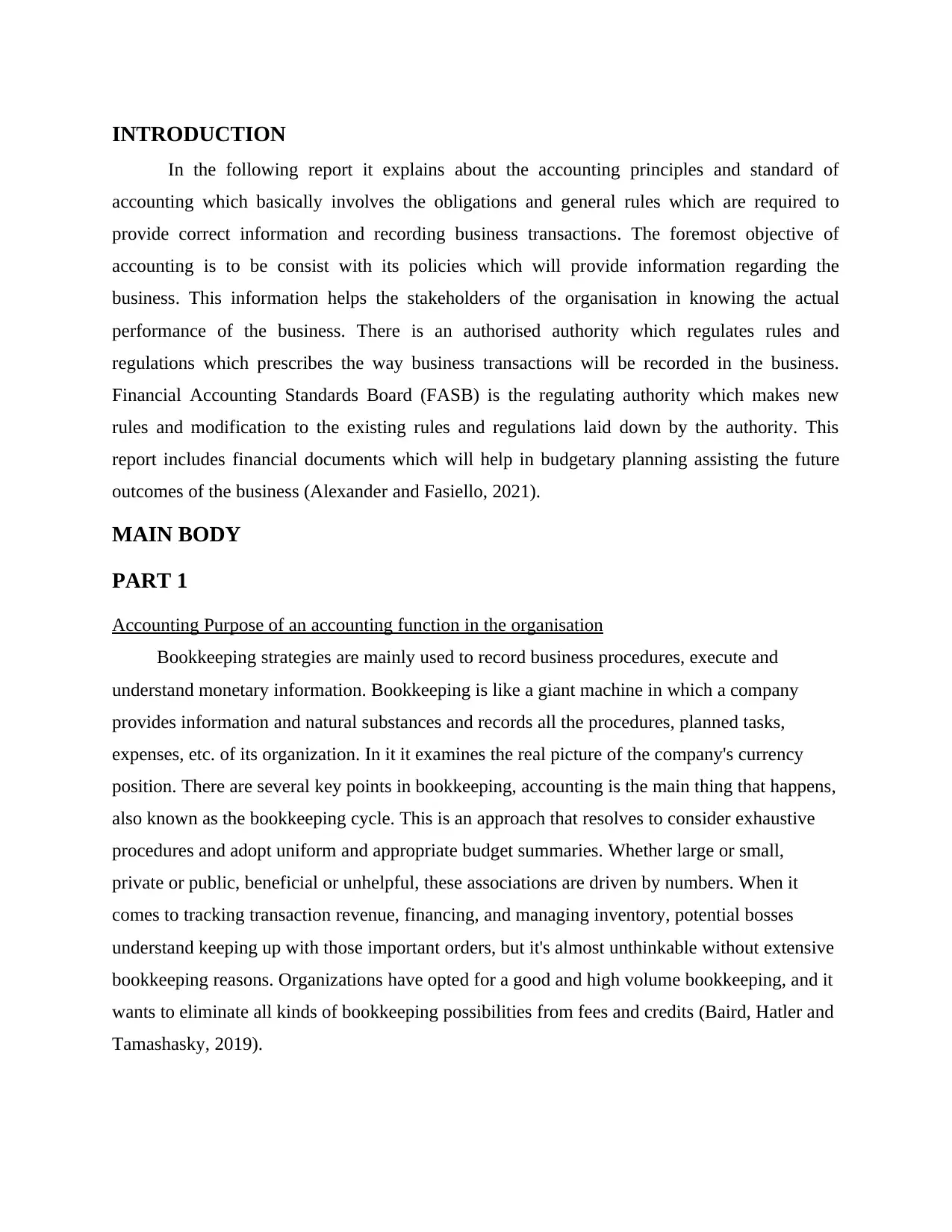
INTRODUCTION
In the following report it explains about the accounting principles and standard of
accounting which basically involves the obligations and general rules which are required to
provide correct information and recording business transactions. The foremost objective of
accounting is to be consist with its policies which will provide information regarding the
business. This information helps the stakeholders of the organisation in knowing the actual
performance of the business. There is an authorised authority which regulates rules and
regulations which prescribes the way business transactions will be recorded in the business.
Financial Accounting Standards Board (FASB) is the regulating authority which makes new
rules and modification to the existing rules and regulations laid down by the authority. This
report includes financial documents which will help in budgetary planning assisting the future
outcomes of the business (Alexander and Fasiello, 2021).
MAIN BODY
PART 1
Accounting Purpose of an accounting function in the organisation
Bookkeeping strategies are mainly used to record business procedures, execute and
understand monetary information. Bookkeeping is like a giant machine in which a company
provides information and natural substances and records all the procedures, planned tasks,
expenses, etc. of its organization. In it it examines the real picture of the company's currency
position. There are several key points in bookkeeping, accounting is the main thing that happens,
also known as the bookkeeping cycle. This is an approach that resolves to consider exhaustive
procedures and adopt uniform and appropriate budget summaries. Whether large or small,
private or public, beneficial or unhelpful, these associations are driven by numbers. When it
comes to tracking transaction revenue, financing, and managing inventory, potential bosses
understand keeping up with those important orders, but it's almost unthinkable without extensive
bookkeeping reasons. Organizations have opted for a good and high volume bookkeeping, and it
wants to eliminate all kinds of bookkeeping possibilities from fees and credits (Baird, Hatler and
Tamashasky, 2019).
In the following report it explains about the accounting principles and standard of
accounting which basically involves the obligations and general rules which are required to
provide correct information and recording business transactions. The foremost objective of
accounting is to be consist with its policies which will provide information regarding the
business. This information helps the stakeholders of the organisation in knowing the actual
performance of the business. There is an authorised authority which regulates rules and
regulations which prescribes the way business transactions will be recorded in the business.
Financial Accounting Standards Board (FASB) is the regulating authority which makes new
rules and modification to the existing rules and regulations laid down by the authority. This
report includes financial documents which will help in budgetary planning assisting the future
outcomes of the business (Alexander and Fasiello, 2021).
MAIN BODY
PART 1
Accounting Purpose of an accounting function in the organisation
Bookkeeping strategies are mainly used to record business procedures, execute and
understand monetary information. Bookkeeping is like a giant machine in which a company
provides information and natural substances and records all the procedures, planned tasks,
expenses, etc. of its organization. In it it examines the real picture of the company's currency
position. There are several key points in bookkeeping, accounting is the main thing that happens,
also known as the bookkeeping cycle. This is an approach that resolves to consider exhaustive
procedures and adopt uniform and appropriate budget summaries. Whether large or small,
private or public, beneficial or unhelpful, these associations are driven by numbers. When it
comes to tracking transaction revenue, financing, and managing inventory, potential bosses
understand keeping up with those important orders, but it's almost unthinkable without extensive
bookkeeping reasons. Organizations have opted for a good and high volume bookkeeping, and it
wants to eliminate all kinds of bookkeeping possibilities from fees and credits (Baird, Hatler and
Tamashasky, 2019).
⊘ This is a preview!⊘
Do you want full access?
Subscribe today to unlock all pages.

Trusted by 1+ million students worldwide
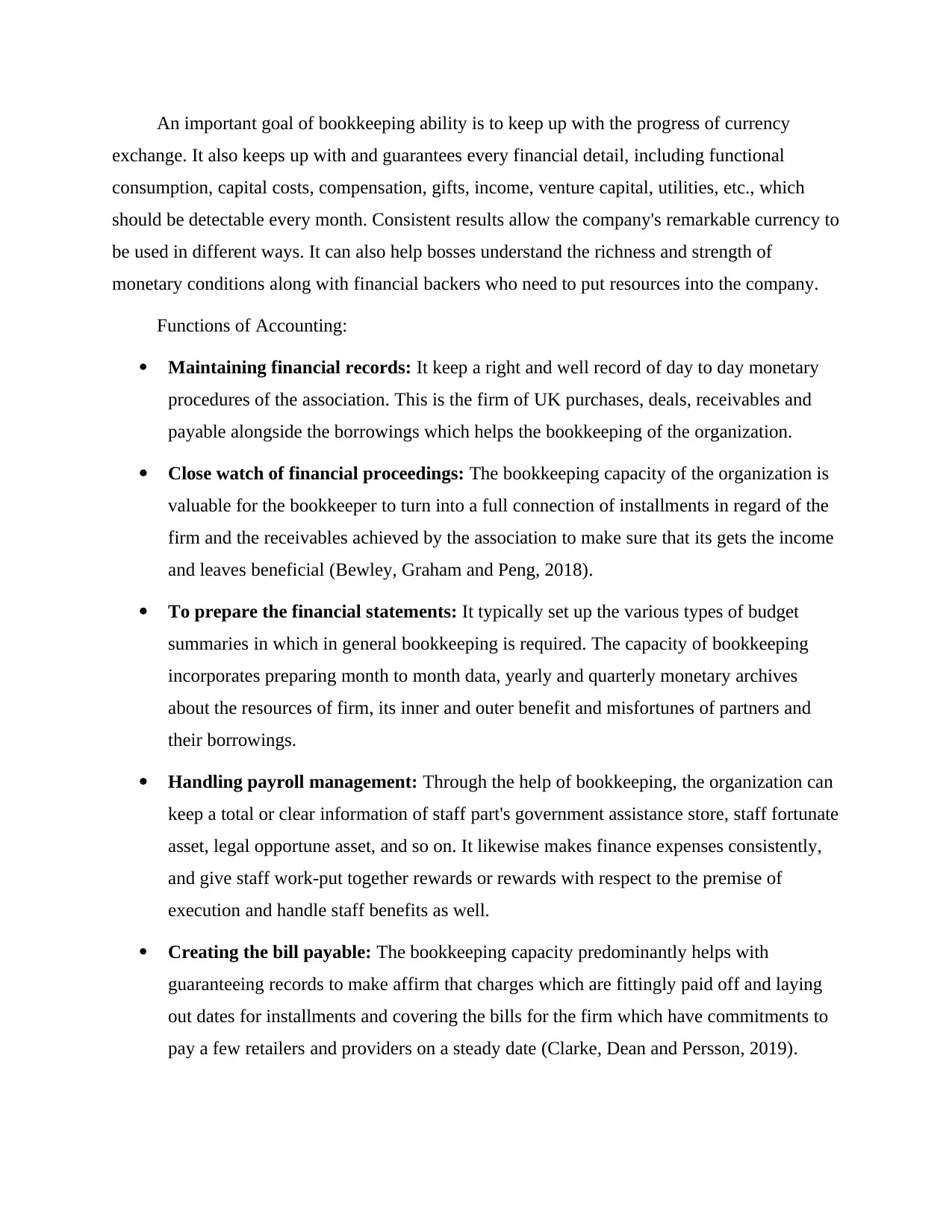
An important goal of bookkeeping ability is to keep up with the progress of currency
exchange. It also keeps up with and guarantees every financial detail, including functional
consumption, capital costs, compensation, gifts, income, venture capital, utilities, etc., which
should be detectable every month. Consistent results allow the company's remarkable currency to
be used in different ways. It can also help bosses understand the richness and strength of
monetary conditions along with financial backers who need to put resources into the company.
Functions of Accounting:
Maintaining financial records: It keep a right and well record of day to day monetary
procedures of the association. This is the firm of UK purchases, deals, receivables and
payable alongside the borrowings which helps the bookkeeping of the organization.
Close watch of financial proceedings: The bookkeeping capacity of the organization is
valuable for the bookkeeper to turn into a full connection of installments in regard of the
firm and the receivables achieved by the association to make sure that its gets the income
and leaves beneficial (Bewley, Graham and Peng, 2018).
To prepare the financial statements: It typically set up the various types of budget
summaries in which in general bookkeeping is required. The capacity of bookkeeping
incorporates preparing month to month data, yearly and quarterly monetary archives
about the resources of firm, its inner and outer benefit and misfortunes of partners and
their borrowings.
Handling payroll management: Through the help of bookkeeping, the organization can
keep a total or clear information of staff part's government assistance store, staff fortunate
asset, legal opportune asset, and so on. It likewise makes finance expenses consistently,
and give staff work-put together rewards or rewards with respect to the premise of
execution and handle staff benefits as well.
Creating the bill payable: The bookkeeping capacity predominantly helps with
guaranteeing records to make affirm that charges which are fittingly paid off and laying
out dates for installments and covering the bills for the firm which have commitments to
pay a few retailers and providers on a steady date (Clarke, Dean and Persson, 2019).
exchange. It also keeps up with and guarantees every financial detail, including functional
consumption, capital costs, compensation, gifts, income, venture capital, utilities, etc., which
should be detectable every month. Consistent results allow the company's remarkable currency to
be used in different ways. It can also help bosses understand the richness and strength of
monetary conditions along with financial backers who need to put resources into the company.
Functions of Accounting:
Maintaining financial records: It keep a right and well record of day to day monetary
procedures of the association. This is the firm of UK purchases, deals, receivables and
payable alongside the borrowings which helps the bookkeeping of the organization.
Close watch of financial proceedings: The bookkeeping capacity of the organization is
valuable for the bookkeeper to turn into a full connection of installments in regard of the
firm and the receivables achieved by the association to make sure that its gets the income
and leaves beneficial (Bewley, Graham and Peng, 2018).
To prepare the financial statements: It typically set up the various types of budget
summaries in which in general bookkeeping is required. The capacity of bookkeeping
incorporates preparing month to month data, yearly and quarterly monetary archives
about the resources of firm, its inner and outer benefit and misfortunes of partners and
their borrowings.
Handling payroll management: Through the help of bookkeeping, the organization can
keep a total or clear information of staff part's government assistance store, staff fortunate
asset, legal opportune asset, and so on. It likewise makes finance expenses consistently,
and give staff work-put together rewards or rewards with respect to the premise of
execution and handle staff benefits as well.
Creating the bill payable: The bookkeeping capacity predominantly helps with
guaranteeing records to make affirm that charges which are fittingly paid off and laying
out dates for installments and covering the bills for the firm which have commitments to
pay a few retailers and providers on a steady date (Clarke, Dean and Persson, 2019).
Paraphrase This Document
Need a fresh take? Get an instant paraphrase of this document with our AI Paraphraser
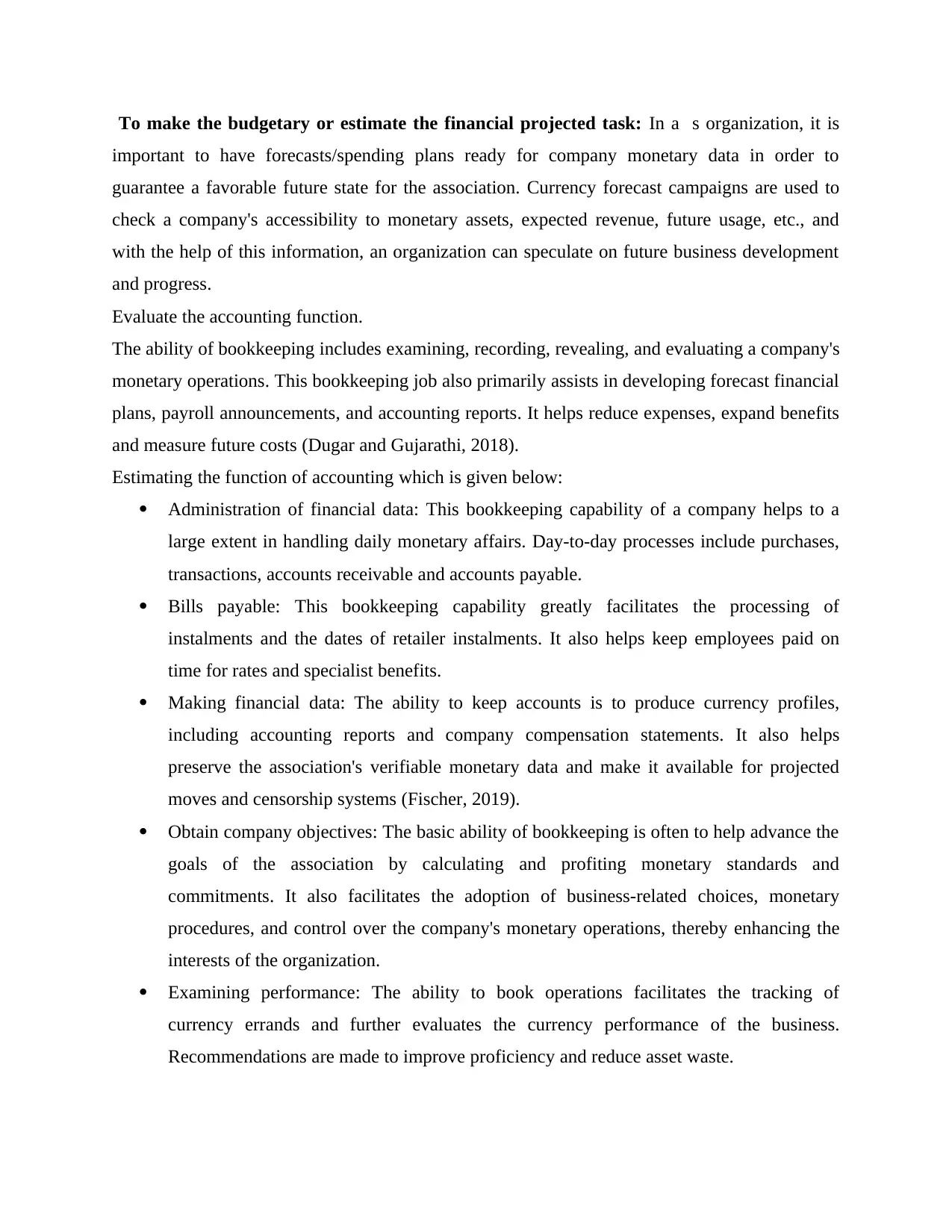
To make the budgetary or estimate the financial projected task: In a s organization, it is
important to have forecasts/spending plans ready for company monetary data in order to
guarantee a favorable future state for the association. Currency forecast campaigns are used to
check a company's accessibility to monetary assets, expected revenue, future usage, etc., and
with the help of this information, an organization can speculate on future business development
and progress.
Evaluate the accounting function.
The ability of bookkeeping includes examining, recording, revealing, and evaluating a company's
monetary operations. This bookkeeping job also primarily assists in developing forecast financial
plans, payroll announcements, and accounting reports. It helps reduce expenses, expand benefits
and measure future costs (Dugar and Gujarathi, 2018).
Estimating the function of accounting which is given below:
Administration of financial data: This bookkeeping capability of a company helps to a
large extent in handling daily monetary affairs. Day-to-day processes include purchases,
transactions, accounts receivable and accounts payable.
Bills payable: This bookkeeping capability greatly facilitates the processing of
instalments and the dates of retailer instalments. It also helps keep employees paid on
time for rates and specialist benefits.
Making financial data: The ability to keep accounts is to produce currency profiles,
including accounting reports and company compensation statements. It also helps
preserve the association's verifiable monetary data and make it available for projected
moves and censorship systems (Fischer, 2019).
Obtain company objectives: The basic ability of bookkeeping is often to help advance the
goals of the association by calculating and profiting monetary standards and
commitments. It also facilitates the adoption of business-related choices, monetary
procedures, and control over the company's monetary operations, thereby enhancing the
interests of the organization.
Examining performance: The ability to book operations facilitates the tracking of
currency errands and further evaluates the currency performance of the business.
Recommendations are made to improve proficiency and reduce asset waste.
important to have forecasts/spending plans ready for company monetary data in order to
guarantee a favorable future state for the association. Currency forecast campaigns are used to
check a company's accessibility to monetary assets, expected revenue, future usage, etc., and
with the help of this information, an organization can speculate on future business development
and progress.
Evaluate the accounting function.
The ability of bookkeeping includes examining, recording, revealing, and evaluating a company's
monetary operations. This bookkeeping job also primarily assists in developing forecast financial
plans, payroll announcements, and accounting reports. It helps reduce expenses, expand benefits
and measure future costs (Dugar and Gujarathi, 2018).
Estimating the function of accounting which is given below:
Administration of financial data: This bookkeeping capability of a company helps to a
large extent in handling daily monetary affairs. Day-to-day processes include purchases,
transactions, accounts receivable and accounts payable.
Bills payable: This bookkeeping capability greatly facilitates the processing of
instalments and the dates of retailer instalments. It also helps keep employees paid on
time for rates and specialist benefits.
Making financial data: The ability to keep accounts is to produce currency profiles,
including accounting reports and company compensation statements. It also helps
preserve the association's verifiable monetary data and make it available for projected
moves and censorship systems (Fischer, 2019).
Obtain company objectives: The basic ability of bookkeeping is often to help advance the
goals of the association by calculating and profiting monetary standards and
commitments. It also facilitates the adoption of business-related choices, monetary
procedures, and control over the company's monetary operations, thereby enhancing the
interests of the organization.
Examining performance: The ability to book operations facilitates the tracking of
currency errands and further evaluates the currency performance of the business.
Recommendations are made to improve proficiency and reduce asset waste.
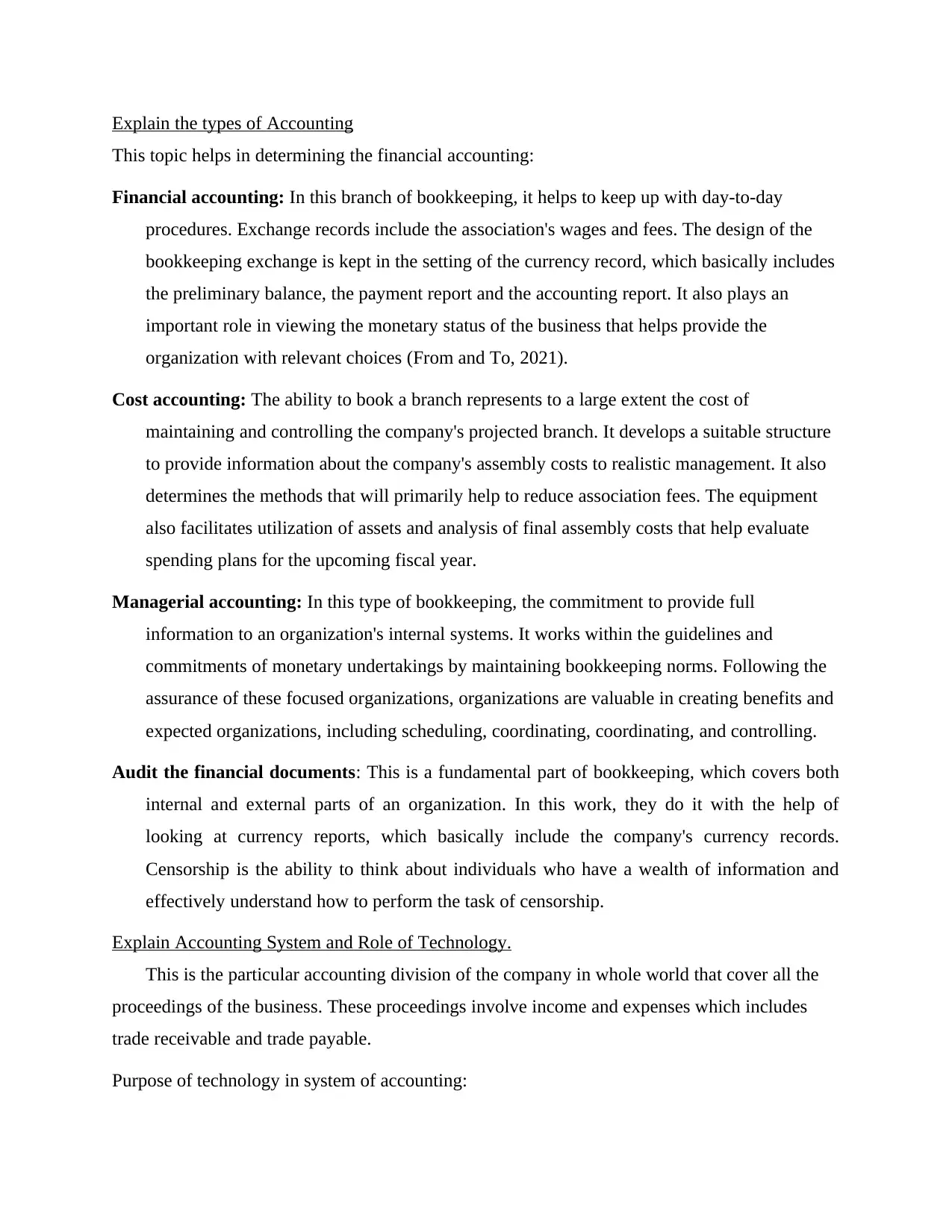
Explain the types of Accounting
This topic helps in determining the financial accounting:
Financial accounting: In this branch of bookkeeping, it helps to keep up with day-to-day
procedures. Exchange records include the association's wages and fees. The design of the
bookkeeping exchange is kept in the setting of the currency record, which basically includes
the preliminary balance, the payment report and the accounting report. It also plays an
important role in viewing the monetary status of the business that helps provide the
organization with relevant choices (From and To, 2021).
Cost accounting: The ability to book a branch represents to a large extent the cost of
maintaining and controlling the company's projected branch. It develops a suitable structure
to provide information about the company's assembly costs to realistic management. It also
determines the methods that will primarily help to reduce association fees. The equipment
also facilitates utilization of assets and analysis of final assembly costs that help evaluate
spending plans for the upcoming fiscal year.
Managerial accounting: In this type of bookkeeping, the commitment to provide full
information to an organization's internal systems. It works within the guidelines and
commitments of monetary undertakings by maintaining bookkeeping norms. Following the
assurance of these focused organizations, organizations are valuable in creating benefits and
expected organizations, including scheduling, coordinating, coordinating, and controlling.
Audit the financial documents: This is a fundamental part of bookkeeping, which covers both
internal and external parts of an organization. In this work, they do it with the help of
looking at currency reports, which basically include the company's currency records.
Censorship is the ability to think about individuals who have a wealth of information and
effectively understand how to perform the task of censorship.
Explain Accounting System and Role of Technology.
This is the particular accounting division of the company in whole world that cover all the
proceedings of the business. These proceedings involve income and expenses which includes
trade receivable and trade payable.
Purpose of technology in system of accounting:
This topic helps in determining the financial accounting:
Financial accounting: In this branch of bookkeeping, it helps to keep up with day-to-day
procedures. Exchange records include the association's wages and fees. The design of the
bookkeeping exchange is kept in the setting of the currency record, which basically includes
the preliminary balance, the payment report and the accounting report. It also plays an
important role in viewing the monetary status of the business that helps provide the
organization with relevant choices (From and To, 2021).
Cost accounting: The ability to book a branch represents to a large extent the cost of
maintaining and controlling the company's projected branch. It develops a suitable structure
to provide information about the company's assembly costs to realistic management. It also
determines the methods that will primarily help to reduce association fees. The equipment
also facilitates utilization of assets and analysis of final assembly costs that help evaluate
spending plans for the upcoming fiscal year.
Managerial accounting: In this type of bookkeeping, the commitment to provide full
information to an organization's internal systems. It works within the guidelines and
commitments of monetary undertakings by maintaining bookkeeping norms. Following the
assurance of these focused organizations, organizations are valuable in creating benefits and
expected organizations, including scheduling, coordinating, coordinating, and controlling.
Audit the financial documents: This is a fundamental part of bookkeeping, which covers both
internal and external parts of an organization. In this work, they do it with the help of
looking at currency reports, which basically include the company's currency records.
Censorship is the ability to think about individuals who have a wealth of information and
effectively understand how to perform the task of censorship.
Explain Accounting System and Role of Technology.
This is the particular accounting division of the company in whole world that cover all the
proceedings of the business. These proceedings involve income and expenses which includes
trade receivable and trade payable.
Purpose of technology in system of accounting:
⊘ This is a preview!⊘
Do you want full access?
Subscribe today to unlock all pages.

Trusted by 1+ million students worldwide
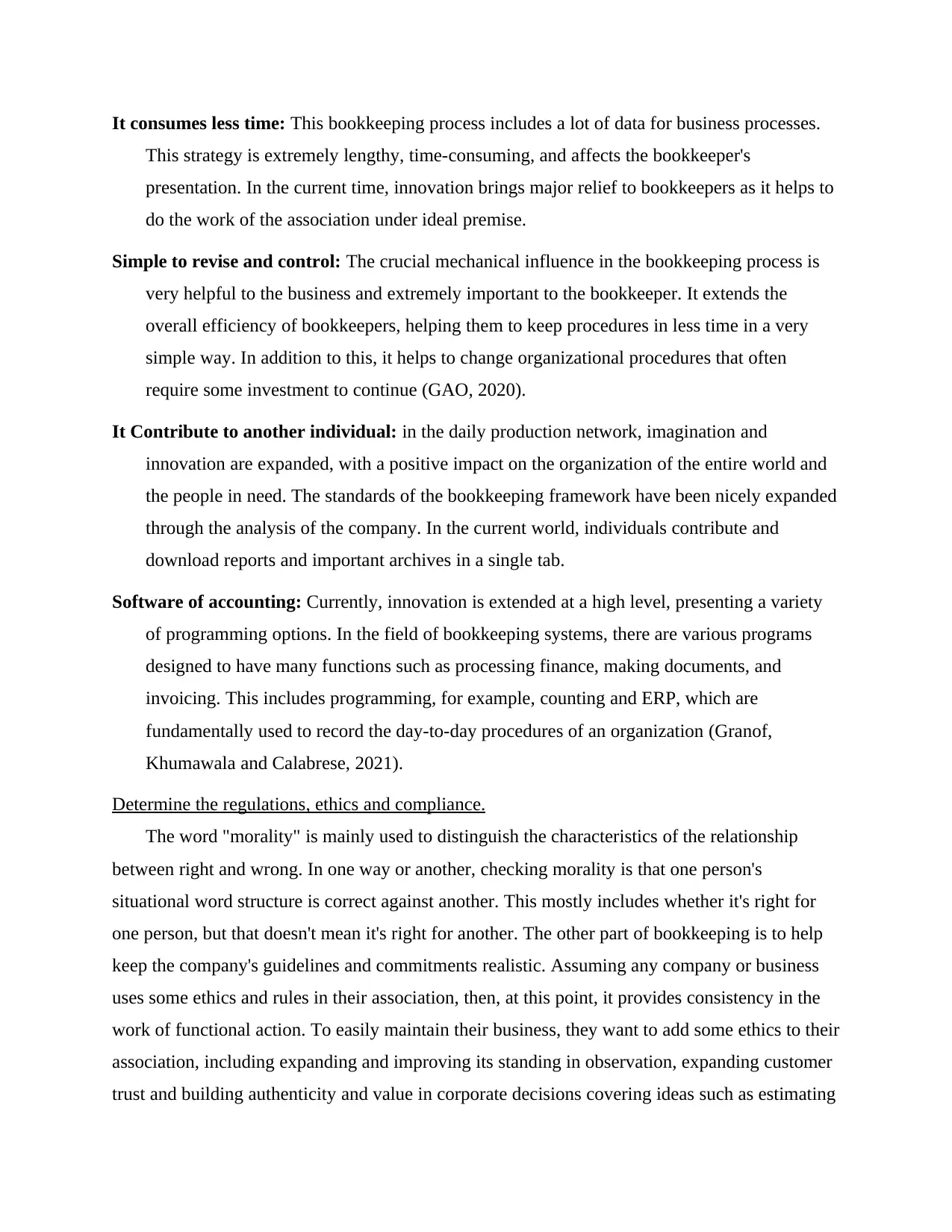
It consumes less time: This bookkeeping process includes a lot of data for business processes.
This strategy is extremely lengthy, time-consuming, and affects the bookkeeper's
presentation. In the current time, innovation brings major relief to bookkeepers as it helps to
do the work of the association under ideal premise.
Simple to revise and control: The crucial mechanical influence in the bookkeeping process is
very helpful to the business and extremely important to the bookkeeper. It extends the
overall efficiency of bookkeepers, helping them to keep procedures in less time in a very
simple way. In addition to this, it helps to change organizational procedures that often
require some investment to continue (GAO, 2020).
It Contribute to another individual: in the daily production network, imagination and
innovation are expanded, with a positive impact on the organization of the entire world and
the people in need. The standards of the bookkeeping framework have been nicely expanded
through the analysis of the company. In the current world, individuals contribute and
download reports and important archives in a single tab.
Software of accounting: Currently, innovation is extended at a high level, presenting a variety
of programming options. In the field of bookkeeping systems, there are various programs
designed to have many functions such as processing finance, making documents, and
invoicing. This includes programming, for example, counting and ERP, which are
fundamentally used to record the day-to-day procedures of an organization (Granof,
Khumawala and Calabrese, 2021).
Determine the regulations, ethics and compliance.
The word "morality" is mainly used to distinguish the characteristics of the relationship
between right and wrong. In one way or another, checking morality is that one person's
situational word structure is correct against another. This mostly includes whether it's right for
one person, but that doesn't mean it's right for another. The other part of bookkeeping is to help
keep the company's guidelines and commitments realistic. Assuming any company or business
uses some ethics and rules in their association, then, at this point, it provides consistency in the
work of functional action. To easily maintain their business, they want to add some ethics to their
association, including expanding and improving its standing in observation, expanding customer
trust and building authenticity and value in corporate decisions covering ideas such as estimating
This strategy is extremely lengthy, time-consuming, and affects the bookkeeper's
presentation. In the current time, innovation brings major relief to bookkeepers as it helps to
do the work of the association under ideal premise.
Simple to revise and control: The crucial mechanical influence in the bookkeeping process is
very helpful to the business and extremely important to the bookkeeper. It extends the
overall efficiency of bookkeepers, helping them to keep procedures in less time in a very
simple way. In addition to this, it helps to change organizational procedures that often
require some investment to continue (GAO, 2020).
It Contribute to another individual: in the daily production network, imagination and
innovation are expanded, with a positive impact on the organization of the entire world and
the people in need. The standards of the bookkeeping framework have been nicely expanded
through the analysis of the company. In the current world, individuals contribute and
download reports and important archives in a single tab.
Software of accounting: Currently, innovation is extended at a high level, presenting a variety
of programming options. In the field of bookkeeping systems, there are various programs
designed to have many functions such as processing finance, making documents, and
invoicing. This includes programming, for example, counting and ERP, which are
fundamentally used to record the day-to-day procedures of an organization (Granof,
Khumawala and Calabrese, 2021).
Determine the regulations, ethics and compliance.
The word "morality" is mainly used to distinguish the characteristics of the relationship
between right and wrong. In one way or another, checking morality is that one person's
situational word structure is correct against another. This mostly includes whether it's right for
one person, but that doesn't mean it's right for another. The other part of bookkeeping is to help
keep the company's guidelines and commitments realistic. Assuming any company or business
uses some ethics and rules in their association, then, at this point, it provides consistency in the
work of functional action. To easily maintain their business, they want to add some ethics to their
association, including expanding and improving its standing in observation, expanding customer
trust and building authenticity and value in corporate decisions covering ideas such as estimating
Paraphrase This Document
Need a fresh take? Get an instant paraphrase of this document with our AI Paraphraser
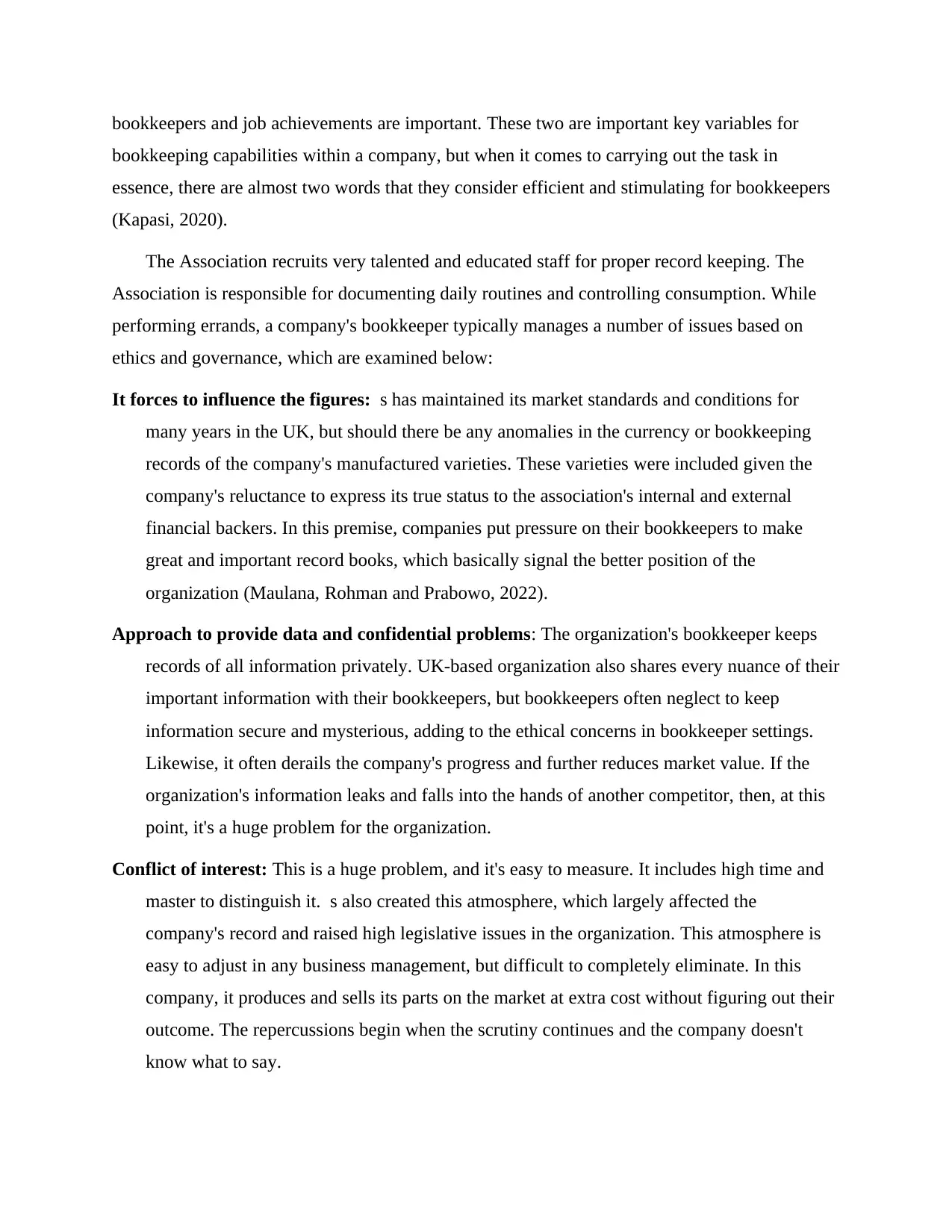
bookkeepers and job achievements are important. These two are important key variables for
bookkeeping capabilities within a company, but when it comes to carrying out the task in
essence, there are almost two words that they consider efficient and stimulating for bookkeepers
(Kapasi, 2020).
The Association recruits very talented and educated staff for proper record keeping. The
Association is responsible for documenting daily routines and controlling consumption. While
performing errands, a company's bookkeeper typically manages a number of issues based on
ethics and governance, which are examined below:
It forces to influence the figures: s has maintained its market standards and conditions for
many years in the UK, but should there be any anomalies in the currency or bookkeeping
records of the company's manufactured varieties. These varieties were included given the
company's reluctance to express its true status to the association's internal and external
financial backers. In this premise, companies put pressure on their bookkeepers to make
great and important record books, which basically signal the better position of the
organization (Maulana, Rohman and Prabowo, 2022).
Approach to provide data and confidential problems: The organization's bookkeeper keeps
records of all information privately. UK-based organization also shares every nuance of their
important information with their bookkeepers, but bookkeepers often neglect to keep
information secure and mysterious, adding to the ethical concerns in bookkeeper settings.
Likewise, it often derails the company's progress and further reduces market value. If the
organization's information leaks and falls into the hands of another competitor, then, at this
point, it's a huge problem for the organization.
Conflict of interest: This is a huge problem, and it's easy to measure. It includes high time and
master to distinguish it. s also created this atmosphere, which largely affected the
company's record and raised high legislative issues in the organization. This atmosphere is
easy to adjust in any business management, but difficult to completely eliminate. In this
company, it produces and sells its parts on the market at extra cost without figuring out their
outcome. The repercussions begin when the scrutiny continues and the company doesn't
know what to say.
bookkeeping capabilities within a company, but when it comes to carrying out the task in
essence, there are almost two words that they consider efficient and stimulating for bookkeepers
(Kapasi, 2020).
The Association recruits very talented and educated staff for proper record keeping. The
Association is responsible for documenting daily routines and controlling consumption. While
performing errands, a company's bookkeeper typically manages a number of issues based on
ethics and governance, which are examined below:
It forces to influence the figures: s has maintained its market standards and conditions for
many years in the UK, but should there be any anomalies in the currency or bookkeeping
records of the company's manufactured varieties. These varieties were included given the
company's reluctance to express its true status to the association's internal and external
financial backers. In this premise, companies put pressure on their bookkeepers to make
great and important record books, which basically signal the better position of the
organization (Maulana, Rohman and Prabowo, 2022).
Approach to provide data and confidential problems: The organization's bookkeeper keeps
records of all information privately. UK-based organization also shares every nuance of their
important information with their bookkeepers, but bookkeepers often neglect to keep
information secure and mysterious, adding to the ethical concerns in bookkeeper settings.
Likewise, it often derails the company's progress and further reduces market value. If the
organization's information leaks and falls into the hands of another competitor, then, at this
point, it's a huge problem for the organization.
Conflict of interest: This is a huge problem, and it's easy to measure. It includes high time and
master to distinguish it. s also created this atmosphere, which largely affected the
company's record and raised high legislative issues in the organization. This atmosphere is
easy to adjust in any business management, but difficult to completely eliminate. In this
company, it produces and sells its parts on the market at extra cost without figuring out their
outcome. The repercussions begin when the scrutiny continues and the company doesn't
know what to say.
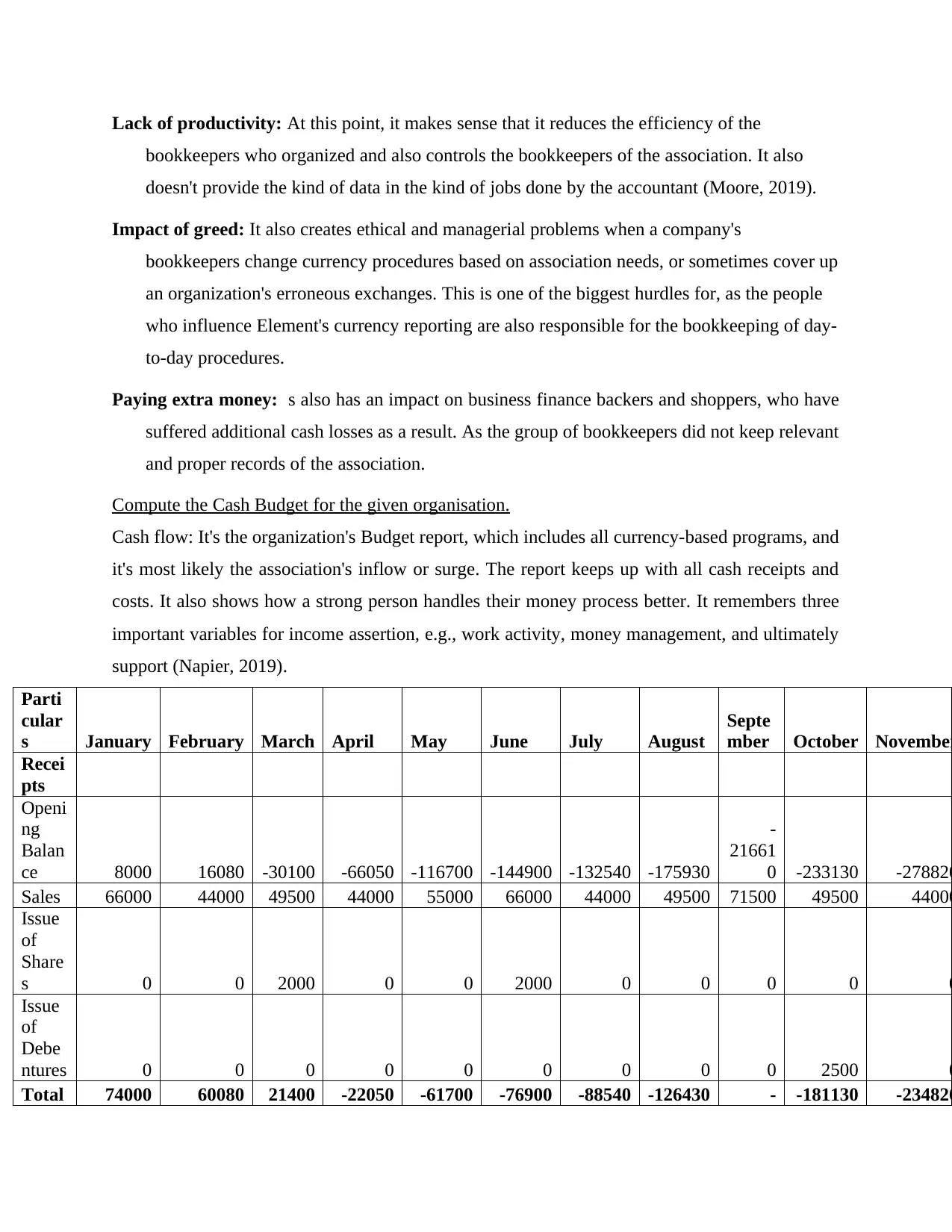
Lack of productivity: At this point, it makes sense that it reduces the efficiency of the
bookkeepers who organized and also controls the bookkeepers of the association. It also
doesn't provide the kind of data in the kind of jobs done by the accountant (Moore, 2019).
Impact of greed: It also creates ethical and managerial problems when a company's
bookkeepers change currency procedures based on association needs, or sometimes cover up
an organization's erroneous exchanges. This is one of the biggest hurdles for, as the people
who influence Element's currency reporting are also responsible for the bookkeeping of day-
to-day procedures.
Paying extra money: s also has an impact on business finance backers and shoppers, who have
suffered additional cash losses as a result. As the group of bookkeepers did not keep relevant
and proper records of the association.
Compute the Cash Budget for the given organisation.
Cash flow: It's the organization's Budget report, which includes all currency-based programs, and
it's most likely the association's inflow or surge. The report keeps up with all cash receipts and
costs. It also shows how a strong person handles their money process better. It remembers three
important variables for income assertion, e.g., work activity, money management, and ultimately
support (Napier, 2019).
Parti
cular
s January February March April May June July August
Septe
mber October November
Recei
pts
Openi
ng
Balan
ce 8000 16080 -30100 -66050 -116700 -144900 -132540 -175930
-
21661
0 -233130 -278820
Sales 66000 44000 49500 44000 55000 66000 44000 49500 71500 49500 44000
Issue
of
Share
s 0 0 2000 0 0 2000 0 0 0 0 0
Issue
of
Debe
ntures 0 0 0 0 0 0 0 0 0 2500 0
Total 74000 60080 21400 -22050 -61700 -76900 -88540 -126430 - -181130 -234820
bookkeepers who organized and also controls the bookkeepers of the association. It also
doesn't provide the kind of data in the kind of jobs done by the accountant (Moore, 2019).
Impact of greed: It also creates ethical and managerial problems when a company's
bookkeepers change currency procedures based on association needs, or sometimes cover up
an organization's erroneous exchanges. This is one of the biggest hurdles for, as the people
who influence Element's currency reporting are also responsible for the bookkeeping of day-
to-day procedures.
Paying extra money: s also has an impact on business finance backers and shoppers, who have
suffered additional cash losses as a result. As the group of bookkeepers did not keep relevant
and proper records of the association.
Compute the Cash Budget for the given organisation.
Cash flow: It's the organization's Budget report, which includes all currency-based programs, and
it's most likely the association's inflow or surge. The report keeps up with all cash receipts and
costs. It also shows how a strong person handles their money process better. It remembers three
important variables for income assertion, e.g., work activity, money management, and ultimately
support (Napier, 2019).
Parti
cular
s January February March April May June July August
Septe
mber October November
Recei
pts
Openi
ng
Balan
ce 8000 16080 -30100 -66050 -116700 -144900 -132540 -175930
-
21661
0 -233130 -278820
Sales 66000 44000 49500 44000 55000 66000 44000 49500 71500 49500 44000
Issue
of
Share
s 0 0 2000 0 0 2000 0 0 0 0 0
Issue
of
Debe
ntures 0 0 0 0 0 0 0 0 0 2500 0
Total 74000 60080 21400 -22050 -61700 -76900 -88540 -126430 - -181130 -234820
⊘ This is a preview!⊘
Do you want full access?
Subscribe today to unlock all pages.

Trusted by 1+ million students worldwide
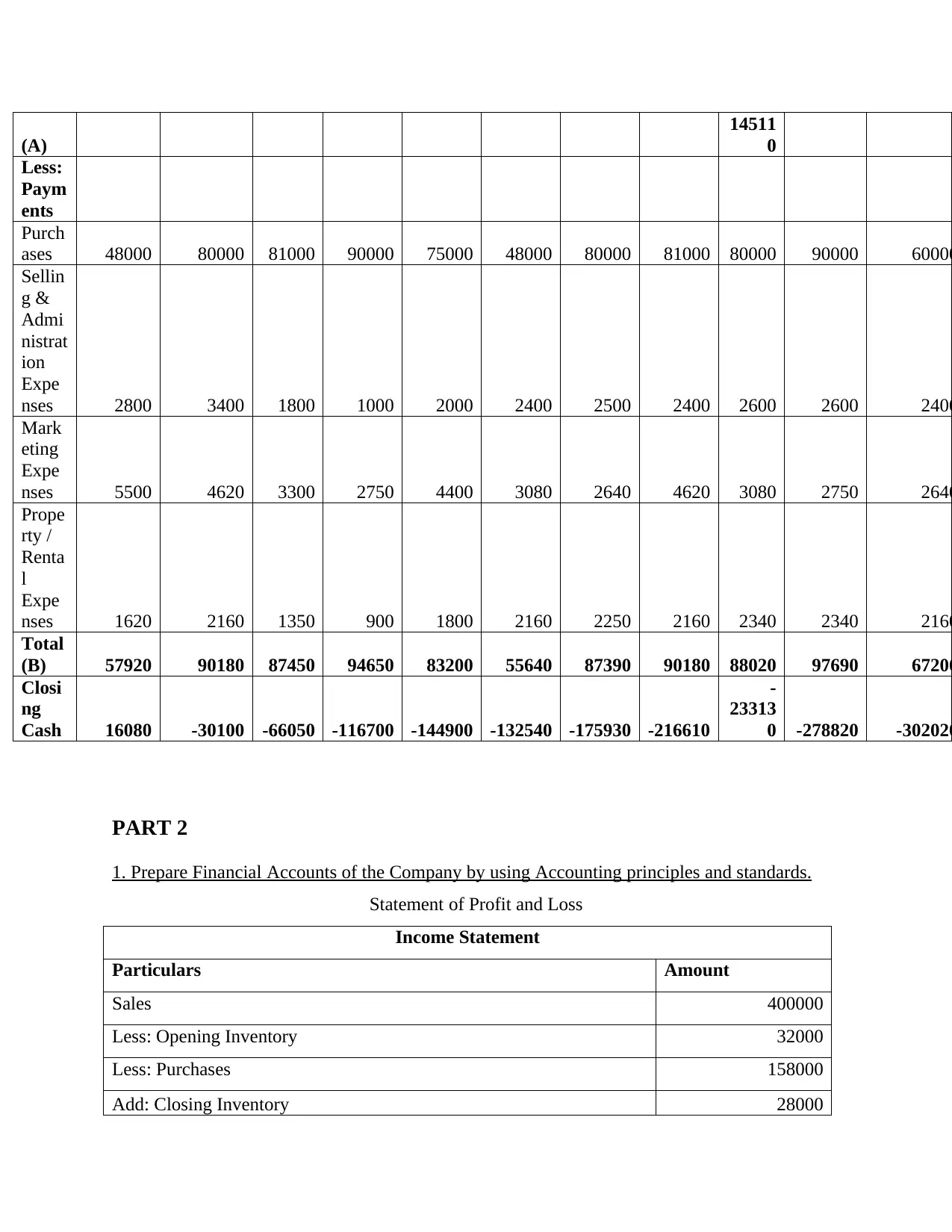
(A)
14511
0
Less:
Paym
ents
Purch
ases 48000 80000 81000 90000 75000 48000 80000 81000 80000 90000 60000
Sellin
g &
Admi
nistrat
ion
Expe
nses 2800 3400 1800 1000 2000 2400 2500 2400 2600 2600 2400
Mark
eting
Expe
nses 5500 4620 3300 2750 4400 3080 2640 4620 3080 2750 2640
Prope
rty /
Renta
l
Expe
nses 1620 2160 1350 900 1800 2160 2250 2160 2340 2340 2160
Total
(B) 57920 90180 87450 94650 83200 55640 87390 90180 88020 97690 67200
Closi
ng
Cash 16080 -30100 -66050 -116700 -144900 -132540 -175930 -216610
-
23313
0 -278820 -302020
PART 2
1. Prepare Financial Accounts of the Company by using Accounting principles and standards.
Statement of Profit and Loss
Income Statement
Particulars Amount
Sales 400000
Less: Opening Inventory 32000
Less: Purchases 158000
Add: Closing Inventory 28000
14511
0
Less:
Paym
ents
Purch
ases 48000 80000 81000 90000 75000 48000 80000 81000 80000 90000 60000
Sellin
g &
Admi
nistrat
ion
Expe
nses 2800 3400 1800 1000 2000 2400 2500 2400 2600 2600 2400
Mark
eting
Expe
nses 5500 4620 3300 2750 4400 3080 2640 4620 3080 2750 2640
Prope
rty /
Renta
l
Expe
nses 1620 2160 1350 900 1800 2160 2250 2160 2340 2340 2160
Total
(B) 57920 90180 87450 94650 83200 55640 87390 90180 88020 97690 67200
Closi
ng
Cash 16080 -30100 -66050 -116700 -144900 -132540 -175930 -216610
-
23313
0 -278820 -302020
PART 2
1. Prepare Financial Accounts of the Company by using Accounting principles and standards.
Statement of Profit and Loss
Income Statement
Particulars Amount
Sales 400000
Less: Opening Inventory 32000
Less: Purchases 158000
Add: Closing Inventory 28000
Paraphrase This Document
Need a fresh take? Get an instant paraphrase of this document with our AI Paraphraser
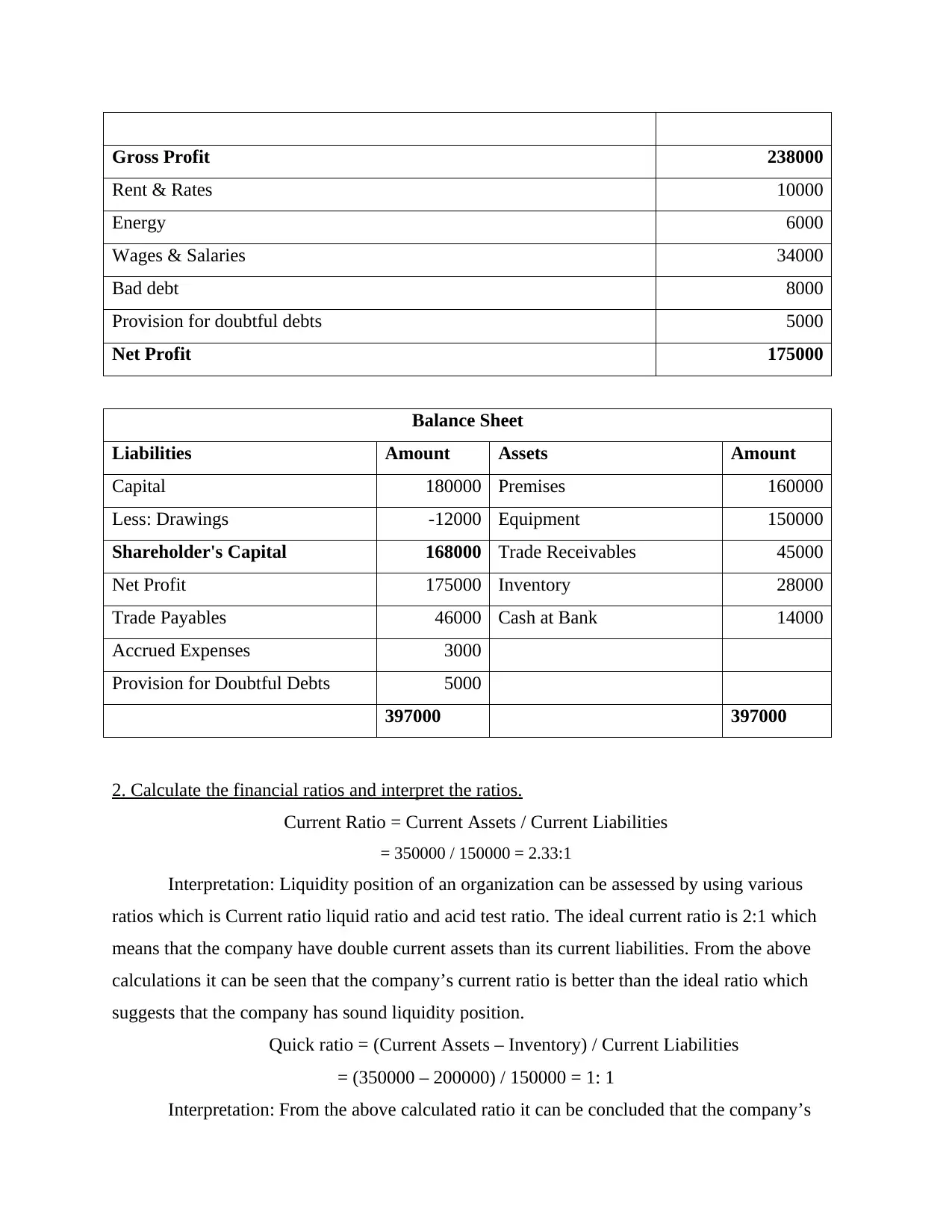
Gross Profit 238000
Rent & Rates 10000
Energy 6000
Wages & Salaries 34000
Bad debt 8000
Provision for doubtful debts 5000
Net Profit 175000
Balance Sheet
Liabilities Amount Assets Amount
Capital 180000 Premises 160000
Less: Drawings -12000 Equipment 150000
Shareholder's Capital 168000 Trade Receivables 45000
Net Profit 175000 Inventory 28000
Trade Payables 46000 Cash at Bank 14000
Accrued Expenses 3000
Provision for Doubtful Debts 5000
397000 397000
2. Calculate the financial ratios and interpret the ratios.
Current Ratio = Current Assets / Current Liabilities
= 350000 / 150000 = 2.33:1
Interpretation: Liquidity position of an organization can be assessed by using various
ratios which is Current ratio liquid ratio and acid test ratio. The ideal current ratio is 2:1 which
means that the company have double current assets than its current liabilities. From the above
calculations it can be seen that the company’s current ratio is better than the ideal ratio which
suggests that the company has sound liquidity position.
Quick ratio = (Current Assets – Inventory) / Current Liabilities
= (350000 – 200000) / 150000 = 1: 1
Interpretation: From the above calculated ratio it can be concluded that the company’s
Rent & Rates 10000
Energy 6000
Wages & Salaries 34000
Bad debt 8000
Provision for doubtful debts 5000
Net Profit 175000
Balance Sheet
Liabilities Amount Assets Amount
Capital 180000 Premises 160000
Less: Drawings -12000 Equipment 150000
Shareholder's Capital 168000 Trade Receivables 45000
Net Profit 175000 Inventory 28000
Trade Payables 46000 Cash at Bank 14000
Accrued Expenses 3000
Provision for Doubtful Debts 5000
397000 397000
2. Calculate the financial ratios and interpret the ratios.
Current Ratio = Current Assets / Current Liabilities
= 350000 / 150000 = 2.33:1
Interpretation: Liquidity position of an organization can be assessed by using various
ratios which is Current ratio liquid ratio and acid test ratio. The ideal current ratio is 2:1 which
means that the company have double current assets than its current liabilities. From the above
calculations it can be seen that the company’s current ratio is better than the ideal ratio which
suggests that the company has sound liquidity position.
Quick ratio = (Current Assets – Inventory) / Current Liabilities
= (350000 – 200000) / 150000 = 1: 1
Interpretation: From the above calculated ratio it can be concluded that the company’s
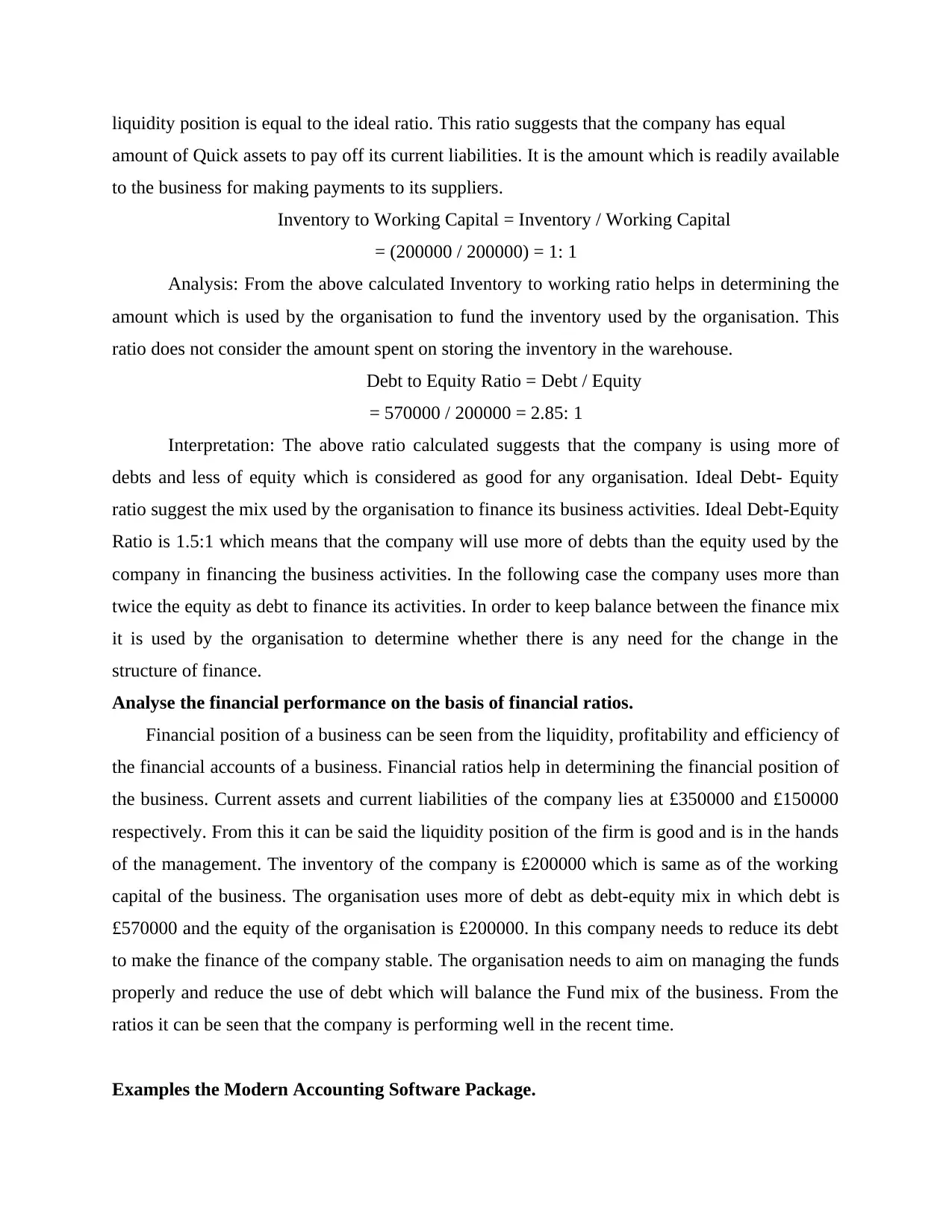
liquidity position is equal to the ideal ratio. This ratio suggests that the company has equal
amount of Quick assets to pay off its current liabilities. It is the amount which is readily available
to the business for making payments to its suppliers.
Inventory to Working Capital = Inventory / Working Capital
= (200000 / 200000) = 1: 1
Analysis: From the above calculated Inventory to working ratio helps in determining the
amount which is used by the organisation to fund the inventory used by the organisation. This
ratio does not consider the amount spent on storing the inventory in the warehouse.
Debt to Equity Ratio = Debt / Equity
= 570000 / 200000 = 2.85: 1
Interpretation: The above ratio calculated suggests that the company is using more of
debts and less of equity which is considered as good for any organisation. Ideal Debt- Equity
ratio suggest the mix used by the organisation to finance its business activities. Ideal Debt-Equity
Ratio is 1.5:1 which means that the company will use more of debts than the equity used by the
company in financing the business activities. In the following case the company uses more than
twice the equity as debt to finance its activities. In order to keep balance between the finance mix
it is used by the organisation to determine whether there is any need for the change in the
structure of finance.
Analyse the financial performance on the basis of financial ratios.
Financial position of a business can be seen from the liquidity, profitability and efficiency of
the financial accounts of a business. Financial ratios help in determining the financial position of
the business. Current assets and current liabilities of the company lies at £350000 and £150000
respectively. From this it can be said the liquidity position of the firm is good and is in the hands
of the management. The inventory of the company is £200000 which is same as of the working
capital of the business. The organisation uses more of debt as debt-equity mix in which debt is
£570000 and the equity of the organisation is £200000. In this company needs to reduce its debt
to make the finance of the company stable. The organisation needs to aim on managing the funds
properly and reduce the use of debt which will balance the Fund mix of the business. From the
ratios it can be seen that the company is performing well in the recent time.
Examples the Modern Accounting Software Package.
amount of Quick assets to pay off its current liabilities. It is the amount which is readily available
to the business for making payments to its suppliers.
Inventory to Working Capital = Inventory / Working Capital
= (200000 / 200000) = 1: 1
Analysis: From the above calculated Inventory to working ratio helps in determining the
amount which is used by the organisation to fund the inventory used by the organisation. This
ratio does not consider the amount spent on storing the inventory in the warehouse.
Debt to Equity Ratio = Debt / Equity
= 570000 / 200000 = 2.85: 1
Interpretation: The above ratio calculated suggests that the company is using more of
debts and less of equity which is considered as good for any organisation. Ideal Debt- Equity
ratio suggest the mix used by the organisation to finance its business activities. Ideal Debt-Equity
Ratio is 1.5:1 which means that the company will use more of debts than the equity used by the
company in financing the business activities. In the following case the company uses more than
twice the equity as debt to finance its activities. In order to keep balance between the finance mix
it is used by the organisation to determine whether there is any need for the change in the
structure of finance.
Analyse the financial performance on the basis of financial ratios.
Financial position of a business can be seen from the liquidity, profitability and efficiency of
the financial accounts of a business. Financial ratios help in determining the financial position of
the business. Current assets and current liabilities of the company lies at £350000 and £150000
respectively. From this it can be said the liquidity position of the firm is good and is in the hands
of the management. The inventory of the company is £200000 which is same as of the working
capital of the business. The organisation uses more of debt as debt-equity mix in which debt is
£570000 and the equity of the organisation is £200000. In this company needs to reduce its debt
to make the finance of the company stable. The organisation needs to aim on managing the funds
properly and reduce the use of debt which will balance the Fund mix of the business. From the
ratios it can be seen that the company is performing well in the recent time.
Examples the Modern Accounting Software Package.
⊘ This is a preview!⊘
Do you want full access?
Subscribe today to unlock all pages.

Trusted by 1+ million students worldwide
1 out of 16
Related Documents
Your All-in-One AI-Powered Toolkit for Academic Success.
+13062052269
info@desklib.com
Available 24*7 on WhatsApp / Email
![[object Object]](/_next/static/media/star-bottom.7253800d.svg)
Unlock your academic potential
Copyright © 2020–2025 A2Z Services. All Rights Reserved. Developed and managed by ZUCOL.

